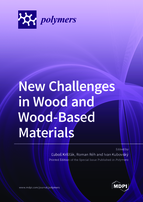New Challenges in Wood and Wood-Based Materials
A special issue of Polymers (ISSN 2073-4360). This special issue belongs to the section "Biomacromolecules, Biobased and Biodegradable Polymers".
Deadline for manuscript submissions: closed (31 May 2021) | Viewed by 33841
Special Issue Editors
Interests: wood-based composites; wood adhesives
Special Issues, Collections and Topics in MDPI journals
Interests: physics; materials; thermal properties; wood sciences; wood physics
Special Issues, Collections and Topics in MDPI journals
Interests: material properties; laser irradiation; physics; electrical engineering; colour; wood sciences
Special Issues, Collections and Topics in MDPI journals
Special Issue Information
Dear Colleagues,
Wood is a natural material, available in large quantities and is easy to produce, making it the perfect material to consider for the circular economy. Its importance has been dramatically increased in recent years. This increase is accompanied by the development of new research methods which open new possibilities in the areas related to wood and wood products in the process of their production, processing and final use.
The main topics of the Special Issue:
- Knowledge of quality of wood and other lignocelluloses materials in relation to processes of their effective utilization and processing for more efficient processing.
- Adopting some of the techniques and research around using wood for environmentally friendly composite production and the positive impact on the environment.
- Wood interaction with solid substances and with different mechanical load, chemical and other substances and different forms of energy.
- Surface modification of wood and wood composites
Assoc. Prof. Dr. Ľuboš Krišťák
Assoc. Prof. Dr. Roman Réh
Assoc. Prof. Dr. Ivan Kubovský
Guest Editors
Manuscript Submission Information
Manuscripts should be submitted online at www.mdpi.com by registering and logging in to this website. Once you are registered, click here to go to the submission form. Manuscripts can be submitted until the deadline. All submissions that pass pre-check are peer-reviewed. Accepted papers will be published continuously in the journal (as soon as accepted) and will be listed together on the special issue website. Research articles, review articles as well as short communications are invited. For planned papers, a title and short abstract (about 100 words) can be sent to the Editorial Office for announcement on this website.
Submitted manuscripts should not have been published previously, nor be under consideration for publication elsewhere (except conference proceedings papers). All manuscripts are thoroughly refereed through a single-blind peer-review process. A guide for authors and other relevant information for submission of manuscripts is available on the Instructions for Authors page. Polymers is an international peer-reviewed open access semimonthly journal published by MDPI.
Please visit the Instructions for Authors page before submitting a manuscript. The Article Processing Charge (APC) for publication in this open access journal is 2700 CHF (Swiss Francs). Submitted papers should be well formatted and use good English. Authors may use MDPI's English editing service prior to publication or during author revisions.
Keywords
- Wood and wood based materials
- Wood composite materials
- Adhesives for composites
- Wood processing and mechanical modification
- Surface modification of wood and wood composites
- Chemical and thermal modification of wood and wood composites







